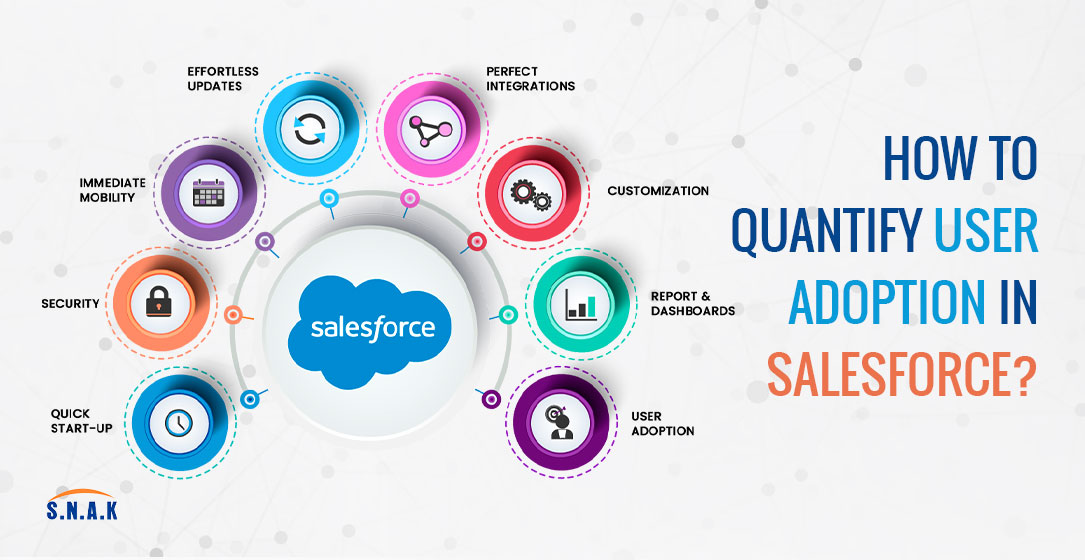August 10, 2023 | SNAK Consultancy
Share on :
How to Quantify User Adoption in Salesforce?

As businesses increasingly rely on Salesforce to manage customer relationships and streamline operations, ensuring user adoption becomes paramount. User adoption is the key to unlocking the true potential of the platform, driving business growth, and maximizing return on investment (ROI). In this blog, we will explore the significance of user adoption in Salesforce and outline essential strategies to quantify and enhance user adoption, ultimately propelling your organization towards success.
Understanding User Adoption:
User adoption refers to the extent to which individuals within an organization embrace and utilize Salesforce to perform their daily tasks efficiently. A high level of user adoption is critical for the successful implementation of Salesforce, as it directly impacts the quality of data, overall productivity, and the ability to make informed decisions. When users fully embrace the platform, they contribute to a cohesive and effective CRM system, leading to improved customer experiences and a competitive advantage in the market
Quantifying User Adoption in Salesforce:
1. Usage Metrics:
a) Login Frequency: Measure how often users access Salesforce. Regular logins indicate that users are actively engaging with the platform.
b) Page Views: Track the number of pages viewed by individual users. A higher number of page views may suggest increased exploration and interaction with Salesforce features.
c) Record Creation/Modification: Monitor the frequency of new records created or existing records modified by users. This metric reflects the extent to which Salesforce is utilized for data management.
d) Reports and Dashboards: Analyze the usage of pre-built and custom reports and dashboards. An active use of these features indicates that users rely on data-driven insights for decision-making.
2. User Activity Metrics:
a) Tasks Completed: Measure the number of tasks completed by users within Salesforce. A high number of completed tasks indicates engagement with the platform to manage daily activities effectively.
b) Opportunities Created: Track the creation of new opportunities by sales representatives. This metric shows how well Salesforce is utilized to identify and manage potential deals.
c) Leads Conversion: Measure the percentage of leads converted to opportunities. A higher conversion rate signifies effective lead management and sales processes.
Data Completeness and Accuracy:
Assess the quality of data in Salesforce by monitoring data completeness and accuracy. An organization with a higher data quality score is likely to have better user trust and adoption.
1. User Feedback and Surveys:
Collect feedback from users through surveys, focus groups, or feedback forms. Insights from users can help identify pain points, training needs, and opportunities for improvement to enhance user adoption.
2.Training Completion Rate:
Evaluate the percentage of users who have completed Salesforce training. Well-trained users are more confident and likely to adopt Salesforce effectively.
3. Mobile Usage:
Analyze how many users access Salesforce through mobile devices. High mobile usage indicates that users find value in accessing Salesforce on-the-go.
Enhancing User Adoption
1. Effective Onboarding and Training:
Implement a comprehensive onboarding process and provide tailored training to equip users with the skills and knowledge they need to use Salesforce effectively.
2. Leadership Buy-In and Support:
Obtain support from top-level management to emphasize the importance of Salesforce adoption. Leadership support can significantly impact user buy-in and commitment to the platform.
3. User-Centric Design:
Customize Salesforce to meet users' specific needs and preferences. An intuitive and user-friendly interface enhances the overall user experience, leading to higher adoption rates.
4. Gamification:
Implement gamification elements, such as leaderboards or rewards, to make using Salesforce more engaging and enjoyable. Gamification can incentivize users to interact with the platform actively.
5. Continuous Support and Resources:
Provide ongoing support and resources to users, including access to training materials, FAQs, and a responsive support team. A well-supported user community fosters higher adoption rates.
6. Regular Communication:
Regularly communicate the benefits of Salesforce adoption, success stories, and tips to encourage users to embrace the platform fully. Effective communication helps build enthusiasm and trust in the platform.
Questionnaire
Ques.1 What are the benefits of personalized recommendations?
Ans. The benefits of personalized content recommendations
1. Increased relevance of recommended content.
2. More efficient discovery of new and interesting content.
3. Personalized recommendations can expose us to diverse perspectives.
4. Ability to tailor content to specific interests and preferences.
Ques.2 What is content based recommendation systems?
Ans. Content-based filtering in recommender systems leverages machine learning algorithms to predict and recommend new but similar items to the user. Recommending products based on their characteristics is only possible if there is a clear set of features for the product and a list of the user's choices.
Ques.3 What is the objective of content based recommendation system?
Ans. Content-based Recommender Systems [28,29] are specifically designed to recommend items similar to the ones that the user has preferred in the past. In CF the similarity between two items (or two users) is calculated in terms of correlation or similarity among ratings provided by other users.
Conclusion:
Content search and personalized content recommendation systems have transformed the digital landscape, empowering users to find information effortlessly and enhancing their overall online experience. Moreover, businesses benefit from increased visibility and user engagement, leading to improved customer satisfaction and higher conversions. As technology advances and data-driven insights improve, content search and recommendation systems will undoubtedly continue to evolve, catering to the ever-changing needs of users and businesses alike.